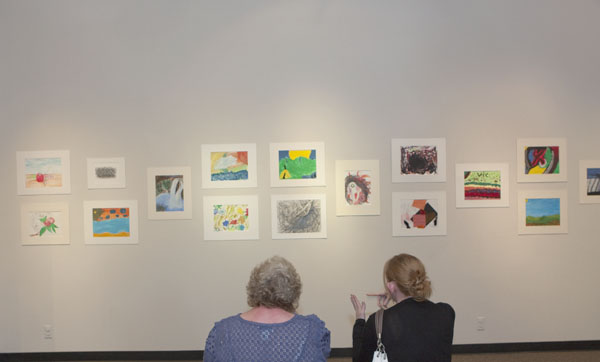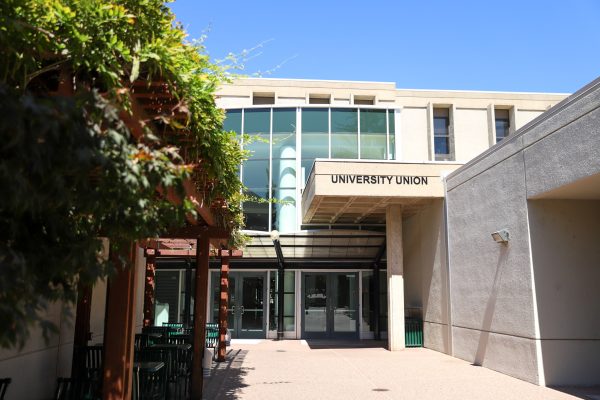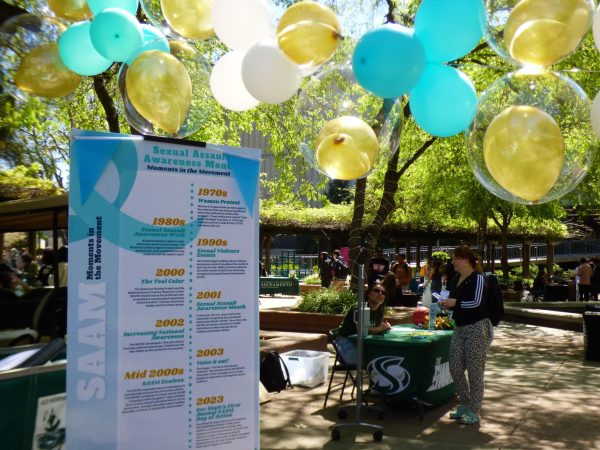Artwork by teenagers in the juvenile justice system exhibited on campus

Juvenile :Viewers discuss art made by students in an art class at the Juvenile Justice Chaplaincy.:Chris Chiang – State Hornet
March 23, 2010
On the farthest left wall of the Sacramento State Library Gallery Annex hangs a piece of art, a butterfly collage, with a young woman’s face in the background, and in the bottom right corner the words “fly away and never look back” are handwritten.
The artist is a teenage girl who made the piece days before leaving Sacramento’s Assessment and Treatment Center for juveniles to enter a group home.
This piece is one of many by students in the Juvenile Justice Chaplaincy art classes at the center, which are being showcased in the Library Gallery Annex this month.
The Juvenile Justice Chaplaincy is a volunteer program that is a branch of Sacramento County’s probation department. The program sponsors volunteers to help rehabilitate students in juvenile detention centers by providing them with productive activities and positive outlets.
The Chaplaincy is contracted with the Sacramento Assessment and Treatment Center to provide art classes once a week to these teenagers; this center also holds teenagers from juvenile hall who are referred through probation officers.
Since the students at the center are minors, they are protected by privacy laws and could not be interviewed or discussed in detail, said Lisa Van Handel-Lane, an art teacher and volunteer at the center.
“Probation officers look at teenagers they think can be helped from juvenile hall, then send them here for us to evaluate. We look to find out where they are in life. By doing the assessments, we have a better insight on their problems and it helps us figure out adequate treatment to find out where they can go after their time is up at the center,” said Leonore Brito, counselor group facilitator at the center.
Leslie Rivers, assistant to the gallery director at Sac State, said the Library Gallery Annex has a history of acquiring art pieces that tell a variety of stories.
The gallery annex provides a room where various people and organizations suggest ideas for showcases to displayed, she said.
“The art department has their own galleries; this one welcomes people from outside the campus community to come to us with ideas. We try to keep a variety of things going so Sac State students can see different kinds of art,” Rivers said.
Van Handel-Lane said she took advantage of this opportunity and suggested the art of her students be placed at the gallery.
Van Handel-Lane has been working at the center since 2006 and said she wanted to display their artwork was because it encouraged the students to focus on their work.
It was also a good way for the students to rehabilitate from whatever experience led them to having to spend time in juvenile hall, she said.
“Before the paintings were hanging here, we had them up at the center and they were so happy and proud to show their work. When I told them about posting their work at Sac State, they were motivated to the point where they were making things on their own time for me to hang,” she said.
Van Handel-Lane said the art classes are beneficial because they provide students with an opportunity express themselves.
“It’s good for them to take their ideas and feelings and to create something of value out of it. It’s something that they can be proud of and it creates a positive environment for them” Van Handel-Lane said.
Brito said for some students, the process of art expression is new, while others are already familiar with it from prior classes they had at juvenile hall.
She said art helps the students occupy their time and opens their eyes to a new world by exploring and discovering things they never had before.
“It helps to widen students’ horizons and think outside their scopes, in the same way foreign languages help students. It teaches them something they don’t know,” Brito said.
Van Handel-Lane said the students are sometimes surprised by the artwork they produce.
“Their work looks like they could have been done by professional painters,” she said.
Van Handel-Lane said it is particularly important for teenagers to have art as an outlet because they have so much to say and so much to think about due to their complicated lives.
The students have all faced a disruption in their lives that has postponed them from reaching their full capability, she said.
With the students just being at the center, it says that they have faced some sort of altercation that led to them standing before a judge, Van Handel-Lane said.
Nevertheless, being at the center also says that probation officers thought they could be helped, she said.
“The students face the stereotype of lacking potential due to their troubled pasts, but they’re quite the opposite. They’re very smart and bright kids, they just need to be challenged and have something to work on,” she said.
Van Handel-Lane said each of the students had all the same materials to work with, but each created art in contrasting ways.
While teaching the students, Van Handel-Lane said, she tries to refrain from telling them what to do and instead gives them creative freedom.
She provides art material and offers things for inspiration such as art books and flowers for the students to draw, but lets the students choose what they wish to create with it.
“It has a lot more to do with them than it does with me; I just provide them the materials and they do the work,” Van Handel-Lane said.
Brito said the showcase shares the positive efforts that are taking place in our community.
These efforts are made possible by volunteers, like Van Handel-Lane, who commit to working with students who are not the easiest to manage, she said.
“Them enjoying the experience of art makes them grow and become better people,” Brito said.
In the past three years, four to five students from the center have pursued art in college, Brito said. Van Handel-Lane said she hopes this year will yield similar results.
Brito said she thinks the program should be offered to more kids in juvenile detention centers by organizations like the Chaplaincy.
“Kids in general now have too much technology and not enough things like music and art. Technology can’t help them the way art can. Art can change their lives and build character. It can help mold them into being upstanding citizens,” Brito said.
Miriam Arghandiwal can be reached at [email protected]








































































































































